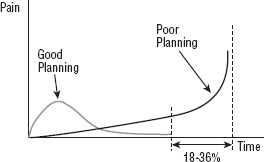Using Tools, Templates, and Processes to Plan a Project
If you were able to do a project twice — once with a good plan and once with a poor or no plan — the project with the good plan would finish earlier, including the time spent planning. The project with a good plan has a higher probability of finishing than does the poorly planned project. The quality is better, the cost is less, and the list of benefits to good planning goes on. So why is planning often seen as not being real work? Figure 5-1 expresses my message clearer than mere words could.
Figure 5-1: Pain curves

“Pay me now or pay me later” applies equally well to the oil change commercial as it does to project planning. When the team and management are anxious for work to begin, it is difficult to focus on developing a solid plan of action before you are pressed into service. At times it would seem that the level of detail in the plan is overkill, but it is not. The project manager must resist the pressure to start project work and instead spend the time up front generating a detailed project plan. It has been demonstrated that a poor planning effort takes its toll later in the project as schedules slip, quality suffers, and expectations are not met.
The pain curve demonstrates that proper planning is painful but pays off in less pain later in the project. To not plan is to expose yourself to significant pain as the project ...
Get Effective Project Management: Traditional, Agile, Extreme, Sixth Edition now with the O’Reilly learning platform.
O’Reilly members experience books, live events, courses curated by job role, and more from O’Reilly and nearly 200 top publishers.

